However, if you can update it or think of a way to further improve it, then please feel free to contribute.
The Cathedral of Emerald Scales was an opulent temple dedicated to Varae located in the city-state of Hlondeth.[4][7] Varae was the goddess[note 1] of a beast cult that worshiped the power of snakes and the Cathedral of Emerald Scales was literally surrounded by and wrapped in snake sculpture. Its domed structure dominated the Hlondeth skyline[3] and influenced the architecture of the entire city.[1][4]
Location
Before the Spellplague, the Cathedral of Emerald Scales was centrally located[3][4] in the independent city-state of Hlondeth, the City of Serpents.[8] Hlondeth was on the northern coast of the Vilhon Reach, an elongated bay on the southern shores of the Sea of Fallen Stars. Hlondeth was south of Turmish, west of Chondath, north of Sespech, and east of the Deepwing Mountains.[9]
Structure
The Cathedral and its grounds occupied a circular area about 520 ft (160 m) in diameter, surrounded by a fortified wall known as the Wall of the Amphisbaena.[2] The portion of the Cathedral that was above ground was a single spherical dome with a radius of about 120 ft (37 m) held up by thirty sturdy pillars—twelve around the outer rim, twelve more in an irregular circle 20 to 40 ft (6 to 12 m) inside the outer ring, and six huge pillars surrounding a central pit.[10] This open area under the dome among the green pillars was affectionately called the Forest of Serpents[1] because the pillars were carved to resemble intertwining snakes.[2]
The dome, known as the Emerald Canopy, was constructed on a gigantic sculpture of a constrictor that spiraled in several coils from the tail on the outer rim to the massive upturned head at the apex.[11] Hlondeth was known for its green marble, mined from the nearby Orsraun Mountains, and all the major stonework of the Cathedral was carved from this material.[3] Between the spiraling coils were mounted large panes of green-tinted, translucent glassteel that admitted sunlight in a diffuse greenish glow. The head of the snake atop the dome pointed its open mouth to the sky and spat out an impressive fountain of water that showered the entire Emerald Canopy and much of the surrounding grounds, known as the Shrouded Jungle. The water also fell through hundreds of small gaps in the marble and glassteel structure, creating a constant light rain under the dome that kept all surfaces wet and slick.[11]
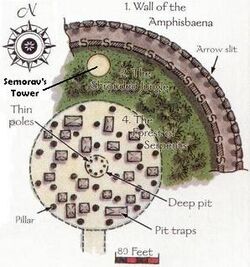
Section of the Wall of the Amphisbaena and layout of the Forest of Serpents.
The Shrouded Jungle was a swath of dense tropical foliage between the Cathedral of Emerald Scales and the Wall of the Amphisbaena that was actually a sliver of the Black Jungles on the Chultan Peninsula[2]. It was kept constantly misty and humid by the fountain atop the Cathedral and maintained steamy jungle temperatures regardless of the weather the rest of Hlondeth experienced. Speculation on the magical nature of the Shrouded Jungle was reinforced by reports from a few surviving trespassers that attempted to cross the grounds unescorted. They reported being lost and wandering for days without coming in contact with either the Wall or the Cathedral, whereas escorted guests, pilgrims, and petitioners testified that the journey from the entrance gate to the Cathedral was a short, easy stroll. This "garden" was well stocked with dozens of species of animals, birds, insects, and plants, many of them quite dangerous or deadly.[1]
In the northern portion of the Shrouded Jungle stood a single tower that was the residence and laboratory of Semorav of the Cobra's Hood, a powerful yuan-ti pureblood necromancer.[1][2]
The Wall of the Amphisbaena was both sculpture and the first line of defense for the Cathedral of Emerald Scales. Built to resemble a snake with a head at both ends, the Wall surrounded the Shrouded Jungle and the two heads met face to face on the southern side,[note 2] forming the only gate into the compound between their open, fanged jaws. The two heads were strongly fortified watch towers guarding the entrance. The body of the snake was about 25 ft (7.6 m) in diameter and contained a narrow corridor that ran through the entire wall, connecting the two guard-tower heads. Secret doors that opened into the Shrouded Jungle were regularly spaced along this tunnel.[1]
Interior
The Forest of Serpents took up the entire space under the Emerald Canopy. It was a huge chamber filled with altars and luxurious statuary made from or decorated with dioptase, clelophane, bloodstone, jade, and emerald. In the center was a large circular pit about 30 ft (9 m) in diameter and approximately 200 ft (61 m) deep. Several thin poles were mounted in a circle within reach of the lip of the pit to allow serpentine bodies to descend into the catacombs beneath the temple or climb back up.[11]
Notable Locations
Below the Cathedral proper was a hodgepodge of chambers in a byzantine warren. There were residences, armories (see Defenses), brood chambers, laboratories, prison pantries, and the unique residence of Medusanna Mhairdaul. The entire labyrinth was designed to impede the progress of bipedal creatures while being conducive to navigation by those with serpentine bodies.[11]
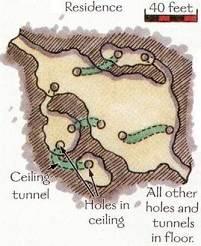
Typical residence chamber.
- Residences
- Upon descending into the catacombs, the first chambers were used as sleeping quarters for 7–12 acolytes and junior priests. A typical dormitory consisted of a central sleeping room riddled with tight twisting passages giving many options for ingress or egress. During the heat of the day, many of the residents slept in a heap in one of these chambers. Other rooms in this area were used for bathing, storing treasure, as chapels or shrines, or privies. Curtains made from molted snakeskin were used to separate rooms. Rats and even giant rats wandered freely until they became a quick meal. Senior priests got their own "private" chambers that were slightly larger, but shared them with the ophidians and lower-ranking specialty priests that lived there to serve and protect them.[11]
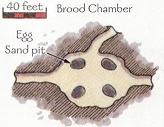
Typical brood chamber.
- Brood Chambers
- These were typically oval-shaped chambers partially filled with sand and heated from a geothermal source. Eggs by the hundreds were buried 4 to 6 inches (10 to 15 centimeters) in the sand and tended constantly by two to twenty histachii.[11]
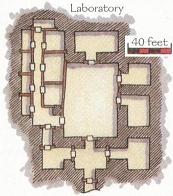
Typical layout of a laboratory.
- Laboratories
- About a dozen of these chambers were dedicated to the yuan-ti penchant for experimenting with the unending variety of life, and death. A typical staff was a team of two or three yuan-ti with a few more ophidians standing guard, as jailers or providing restraint. Each laboratory had at least one dissection table with tools that could be used for science or torture, a small library, creatures preserved by taxidermy, organs preserved in bottles, and a set of holding cells for their test subjects. Those that survived and were considered harmless were discarded to wander around the neighborhood. Mongrelmen and other more abominable creatures who escaped or were released could be found in the tunnels nearby.[11]
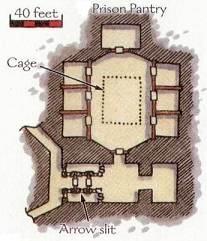
Typical layout of a prison pantry.
- Prison Pantries
- Many of the chambers in the catacombs were used for storing or growing food. Some were essentially subterranean zoos in which live creatures were kept until they became nourishment. Sentient creatures were often released into the Shrouded Jungle and hunted. Dead meat was stored in a chamber containing a brown mold colony for its preservation ability. At least two chambers were the lairs of deepspawn, which presumably helped with the disposal of bodies and produced edible creatures. While most of the prison pantries were watched by one or two ophidians, the deepspawn lairs were heavily guarded.[11]
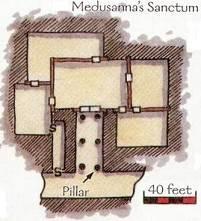
Layout of Medusanna's sanctum.
- Medusanna's Sanctum
- The chambers belonging to Medusanna were large, lavishly furnished, and decorated with many treasures from up and down the Vilhon Reach. She favored mirrors of all shapes and sizes throughout her suite of rooms. This was also her office, where she directed the administration of the Cathedral complex. A secret panel in one of her rooms led to a room that contained a two-way portal to a location in the Black Jungles on the northwestern shore of the Lapal Sea called the Pit of Vipers.[11]
Activities
Petitioners and pilgrims, politicians and envoys, merchants and mercenaries could come and go at all hours of the day or night, but most temple business was conducted in the early morning or late evening as many of the priests slept through the heat of the day. The Amphisbaena Gate never closed, but arrivals and departures decreased greatly at night. All meetings and important ceremonies were held under the Emerald Canopy. Medusanna kept some ceremonial activity (often involving sacrifice) going all the time, believing that Sseth was best served by constant worship and as a reminder to visitors of the power and authority of the Varaen clergy. The background din of the ceremonial procedures and the constant patter of raindrops provided at least some privacy in the open and cavernous Cathedral.[1]
Defenses
The Wall of the Amphisbaena surrounded the Shrouded Jungle and began and ended with the two heavily fortified guard towers sculpted to look like the open mouths of striking snakes. Arrow slits covered the entrance from both sides to prevent any blind spots, and more arrow slits were hidden in the scales along the entire length of the outer wall, accessible by the narrow tunnel that connected the two towers. This passageway was regularly patrolled by small squads of ophidians. On the inner Wall, approximately thirty-six secret doors were spaced evenly along the entire corridor allowing guards to slip into the Shrouded Jungle on patrol, in pursuit, or for a surprise attack.[1]
The Shrouded Jungle itself was a formidable obstacle to interlopers, being much bigger than the containing wall would indicate. How the residents of the Cathedral of Emerald Scales could foreshorten the distance between the gate and the Cathedral, or navigate their way through the Jungle without getting lost, was a well-guarded secret.[1] The Shrouded Jungle contained a menagerie of creatures allowed to exist in their wild state, which contributed to the defense of the Cathedral. Some known denizens of the Jungle were fire beetles, giant horseflies, giant bluebottle flies, giant ticks, rhinoceros beetles, ettercaps, tenebrous worms, swarms of leeches, carnivorous bats, stirges, poisonous frogs, giant toads, vegepygmies, muckdwellers, shambling mounds, quickwoods, su-monsters, hydras, tasloi, will-o'-wisps, and of course, snakes, of the giant constrictor, giant poisonous, spitting, winged, and amphisbaena types, plus the snake-like jaculi.[11]
The Forest of Serpents was constantly active with ceremonies, rituals, and sacrifices, but each of the thirty pillars was home to several jaculi that were difficult to spot because they blended in with the green marble and were obscured by the constant rain. Also, ophidian patrols regularly crisscrossed the area while others stood guard or attended the yuan-ti clerics. The floor was riddled with hidden trapdoors ready to drop the unwary or unwelcome into pits of poisonous vipers.[11]
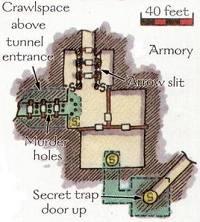
.Typical layout of an armory chamber.
In the catacombs beneath the Cathedral of Emerald Scales were many small armories that were provisioned with weapons, armor, and food and water rations to support twenty warriors for a month. Each armory had at least three thoroughly trapped entrances and at least three ophidians constantly stationed there. The organization and layout of these armories were in response to a lesson painfully learned during a kobold invasion in the Year of Tatters, 527 DR—they were designed to allow the yuan-ti defenders to resist any infiltrators coming through the catacombs.[11]
In the Year of the Tankard, 1370 DR, the Cathedral of Emerald Scales was home to some 120 clerics, crusaders, and serphidians (specialty priests) of Sseth, usually through the worship of his aspect Varae. The crusaders formed an elite military group called the Knights of the Forked Tongue.[1] In addition, the spirit naga Ssibalentanamas was conducting a large-scale breeding program in the catacombs, ostensibly to create an army of yuan-ti for the defense of Hlondeth. The size of this army was unknown to all but Ssibalentanamas and Medusanna Mhairdaul.[1] The brood chambers were tended by mostly mindless histachii who would attack any intruder that did not have reptilian features, but they could not be called upon to defend other parts or populations of the Cathedral.[11]
History
This history of the Cathedral of Emerald Scales is closely tied to the history of House Extaminos in Hlondeth. Already a prominent merchant family, having made their fortune mining green marble from the Orsraun Mountains and trading it across the Vilhon Reach and the Inner Sea, the defeat of the first siege of Hlondeth by the armies of Dempster Turmish in the Year of the Pirates' Port, 145 DR, gave the Extaminos clan a windfall of business when trade resumed.[3][12] With the threat of war abated by the death (from natural causes) of Dempster Turmish,[13] the next hundred years were known as the Calmwaters and were a period of great prosperity for House Extaminos.[3][12] In a munificent gesture of piety, the Extaminos manor was completely rebuilt in green marble and converted into a shrine to Ilmater that was indebted to the Extaminos family and did not become much more than a fancy estate-bound temple.[3]
When nearby Mount Ugruth erupted in the Year of the Speaking Mountain, 257 DR, the resulting social unrest unseated House Gestin as rulers of Hlondeth,[14] and before House Extaminos could capitalize on the power vacuum, the Chondathian army swooped in and seized the city.[15] House Illistine of Chondath ruled for almost three hundred years, and during that time the Extaminos clan slid into decadence but still maintained their trade empire. The temple of Ilmater was expanded and a green stone wall was built to protect the temple and the family manor (and the family fortune) from any depredation by House Illistine or House Gestin. The young Extaminos nobles began to go adventuring to far-flung locations such as Chult, Kara-Tur, and Zakhara, bringing back exotic plants and animals, including many reptiles, which they planted or housed behind the wall of their family home and temple.[3]
In the Year of Tatters, 527 DR, Hlondeth was overrun by a kobold army called the Tattered Cloth Legion,[16] and Lord Shevron Extaminos took in all refugees that managed to escape the slaughter and make it to his gate. The family compound became a bastion against the siege.[1][17] As the siege wore on for the better part of a tenday, Lord Shevron prayed to Ilmater for guidance and Ilmater sent a vision showing him how to gather an army of snakes from his gardens and lead them against the kobolds. The tactic was successful and the siege was broken when the kobolds fled the battleground, but the brave noble was killed in the battle. The snakes then disappeared into the sewers of Hlondeth.[1][18]
In the aftermath of the attack by the kobold army, it was discovered that the invasion was instigated by dark elves, dispatched by Queen Nathglaryst of Undraeth[16] and led by Shilaris Shemwith who absconded with the Hlondethan treasury, possibly hiding a portion of it in the catacombs below the city and retreating to the Underdark with the remainder.[18] The scions of the Extaminos family shook off their indolence and began searching the sewers and catacombs of Hlondeth in search of this treasure, their escaped "pets", and the connection to the Underdark that allowed the kobolds to surprise and overwhelm the city's defenses. At the same time, they renewed their interest in politics and began extending their reach into the power structure of the city once again.[1]
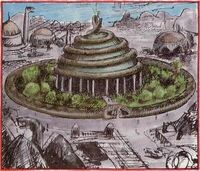
Alternate external view of Cathedral.
The Extaminos adventurers eventually discovered in the catacombs a lost temple of Varae and Lord Shevron's army of snakes. Tablets recovered from the ancient temple vault contained rituals that brought them to the attention of the yuan-ti.[19] Forsaking their family's dedication to Ilmater, they began to revive the cult of Varae and slowly started interbreeding with the yuan-ti. As a result of their political machinations, the Extaminos family infiltrated the government hierarchy and instigated a series of minor rebellions against Chondathan rule, which culminated in Hlondeth regaining its independence in the Year of the Shattered Scepter, 614 DR.[1][18] Instead of seizing power at last, House Extaminos chose to stay behind the scenes, ruling from the shadows for the next four hundred years. As for the family's temple to Ilmater, less than ten years after the rebellion it was renamed the Chapel of Emerald Scales and consecrated to the glory of Varae. The people of Hlondeth still thought highly of the Extaminos clan and did not overly object to what the family chose to do with their temple.[1]
By the Year of the Smoldering Spells, 1020 DR, the Chapel of Emerald Scales had been expanded to five times its original size, the Extaminos villas had expanded throughout the noble's district, and the Extaminos clan had fully made the transition to being yuan-ti. House Extaminos openly ruled Hlondeth and over the next 350 years the Cathedral of Emerald Scales was finished and much of Hlondeth had embraced the architectural style of green marble and snake motif.[1]
After the Spellplague, much of the water drained from the Vilhon Reach leaving the cities along the coast high and dry. The area surrounding erstwhile Hlondeth became known as the Vilhon Wilds and all but the city of Ormpetarr was eventually abandoned or declined to obscurity.[20][21]
Rumors & Legends
- The Shrouded Jungle was rumored to contain a "jungle giant" that was ensorcelled and sleeping, to be awakened in dire need to defend the temple.[11]
- It was said that the head of House Extaminos could cause the fountain atop the Cathedral to spit snake venom that did not harm plants or reptiles but was deadly to other creatures. This claim was never verified.[11]
- When the Tattered Cloth Legion were routed from besieging Hlondeth, it was said that the dark elf leader, Shilaris Shemwith, hid a portion of the city treasury in the sewers and took the rest with her back to the Underdark. Neither Shilaris nor the treasure were ever found.[18]
Inhabitants
- Emerald Boa of the Vilhon, Medusanna Mhairdaul (yuan-ti abomination): Leader of the Council of Elder Serpents, she was the priest of highest rank at the Cathedral. She did not get along with Dediana Extaminos, the ruler of Hlondeth as of 1370 DR.[1]
- First Keeper of the Sacred Eggs, Ssibalentanamas (spirit naga): He was responsible for the brood chambers and the histachii that guarded and tended them. He was also the First Consort of Dediana Extaminos.[1]
- Semorav of the Cobra's Hood (yuan-ti pureblood): This powerful necromancer was the sole representative of the Coiled Cabal in the Cathedral. He performed blasphemous experiments in his tower just north of the temple and dumped the results into the city sewer. He pretended to be Medusanna's personal scribe when it was necessary he go out in public. Only she knew of his necromantic skills.[1]
Appendix
See Also
Notes
- ↑ There is some discrepancy about the predominant gender of Varae. The Powers & Pantheons sourcebook uses the possessive pronoun "his" on page 85 and the Champions of Ruin sourcebook refers to Varae as a goddess on page 11. All sources agree that Varae was revealed to be an aspect of Sseth.
- ↑ There is a discrepancy between the artist's rendering of the Cathedral and the map. The illustration shows the waters of the Vilhon Reach in the background, which must be south of the structure because of the location of Hlondeth. Therefore the illustration puts the entrance on the north side of the Cathedral. However, the map contains a compass rose that clearly indicates the entrance to the Cathedral is on the south side.
References
- ↑ 1.00 1.01 1.02 1.03 1.04 1.05 1.06 1.07 1.08 1.09 1.10 1.11 1.12 1.13 1.14 1.15 1.16 1.17 1.18 1.19 1.20 1.21 1.22 1.23 1.24 Eric L. Boyd (September 1997). Powers & Pantheons. Edited by Julia Martin. (TSR, Inc.), p. 139. ISBN 978-0786906574.
- ↑ 2.0 2.1 2.2 2.3 2.4 2.5 Ed Greenwood, Eric L. Boyd, Darrin Drader (July 2004). Serpent Kingdoms. (Wizards of the Coast), p. 94. ISBN 0-7869-3277-5.
- ↑ 3.0 3.1 3.2 3.3 3.4 3.5 3.6 3.7 Eric L. Boyd (September 1997). Powers & Pantheons. Edited by Julia Martin. (TSR, Inc.), p. 138. ISBN 978-0786906574.
- ↑ 4.0 4.1 4.2 4.3 4.4 4.5 Ed Greenwood, Eric L. Boyd, Darrin Drader (July 2004). Serpent Kingdoms. (Wizards of the Coast), p. 93. ISBN 0-7869-3277-5.
- ↑ Brian R. James, Ed Greenwood (September 2007). The Grand History of the Realms. Edited by Kim Mohan, Penny Williams. (Wizards of the Coast), p. 142. ISBN 978-0-7869-4731-7.
- ↑ Thomas M. Costa (November 2003). “Faiths of Faerûn: Elder Serpents of Set”. In Chris Thomasson ed. Dragon #313 (Paizo Publishing, LLC), p. 85.
- ↑ Jeff Crook, Wil Upchurch, Eric L. Boyd (May 2005). Champions of Ruin. (Wizards of the Coast), p. 13. ISBN 0-7869-3692-4.
- ↑ Jim Butler (1996). The Vilhon Reach (Dungeon Master's Guide). (TSR, Inc), p. 50. ISBN 0-7869-0400-3.
- ↑ Map included in Ed Greenwood, Sean K. Reynolds, Skip Williams, Rob Heinsoo (June 2001). Forgotten Realms Campaign Setting 3rd edition. (Wizards of the Coast). ISBN 0-7869-1836-5.
- ↑ Eric L. Boyd (September 1997). Powers & Pantheons. Edited by Julia Martin. (TSR, Inc.), p. 169. ISBN 978-0786906574.
- ↑ 11.00 11.01 11.02 11.03 11.04 11.05 11.06 11.07 11.08 11.09 11.10 11.11 11.12 11.13 11.14 Eric L. Boyd (September 1997). Powers & Pantheons. Edited by Julia Martin. (TSR, Inc.), p. 141. ISBN 978-0786906574.
- ↑ 12.0 12.1 Jim Butler (1996). The Vilhon Reach (Dungeon Master's Guide). (TSR, Inc), p. 6. ISBN 0-7869-0400-3.
- ↑ Brian R. James, Ed Greenwood (September 2007). The Grand History of the Realms. Edited by Kim Mohan, Penny Williams. (Wizards of the Coast), p. 64. ISBN 978-0-7869-4731-7.
- ↑ Brian R. James, Ed Greenwood (September 2007). The Grand History of the Realms. Edited by Kim Mohan, Penny Williams. (Wizards of the Coast), p. 68. ISBN 978-0-7869-4731-7.
- ↑ Jim Butler (1996). The Vilhon Reach (Dungeon Master's Guide). (TSR, Inc), p. 7. ISBN 0-7869-0400-3.
- ↑ 16.0 16.1 Brian R. James, Ed Greenwood (September 2007). The Grand History of the Realms. Edited by Kim Mohan, Penny Williams. (Wizards of the Coast), p. 90. ISBN 978-0-7869-4731-7.
- ↑ Jim Butler (1996). The Vilhon Reach (Dungeon Master's Guide). (TSR, Inc), p. 9. ISBN 0-7869-0400-3.
- ↑ 18.0 18.1 18.2 18.3 Jim Butler (1996). The Vilhon Reach (Dungeon Master's Guide). (TSR, Inc), p. 10. ISBN 0-7869-0400-3.
- ↑ Jeff Crook, Wil Upchurch, Eric L. Boyd (May 2005). Champions of Ruin. (Wizards of the Coast), p. 11. ISBN 0-7869-3692-4.
- ↑ Bruce R. Cordell, Ed Greenwood, Chris Sims (August 2008). Forgotten Realms Campaign Guide. Edited by Jennifer Clarke Wilkes, et al. (Wizards of the Coast), p. 86. ISBN 978-0-7869-4924-3.
- ↑ Rob Heinsoo, Logan Bonner, Robert J. Schwalb (September 2008). Forgotten Realms Player's Guide. (Wizards of the Coast), p. 126. ISBN 978-0-7869-4929-8.
